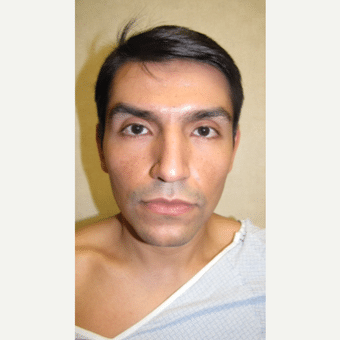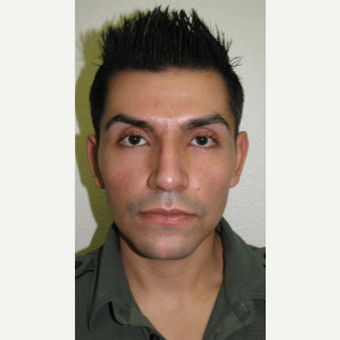
Rhinoplasty is one of the most common plastic surgery procedures. It's performed to reshape, reduce or augment a person’s nose. Results depend on the patient’s nasal bone and cartilage structure, facial shape, skin thickness and age. Insurance may cover rhinoplasty if it is done for reconstructive or medical reasons, but not for cosmetic purposes.
This outpatient procedure typically performed under general anesthesia and takes one to two hours unless more extensive work needs to be done. Dr. Mitchell uses one of two techniques:
The incision is either made within the nostrils, thus hiding scars after surgery, or across the columella (the vertical strip of tissue separating the nostrils) in an “open” procedure, where scars are small and hidden on the underside of the base. In both procedures the skin is lifted, the bone and cartilage sculpted, and the skin replaced and stitched closed.
Rhinoplasty
If you are self-conscious about your nose, this surgery could open up new possibilities for changing your appearance and your self-image.
Rhinoplasty may involve:
- Removing a hump
- Narrowing nostril width
- Changing the angle between the nose and the mouth
- Correcting an injury, birth defects or other problems that affect breathing
FAQs About Rhinoplasty
Rhinoplasty is one of the most common plastic surgery procedures. Rhinoplasty is performed to reshape, reduce or augment a person’s nose. Rhinoplasty may involve; removing a hump, narrowing nostril width and changing the angle between the nose and the mouth, or to correct injury, birth defects, or other problems that affect breathing.
Septoplasty is a surgical procedure performed on the nasal septum. The nasal septum is the structure (wall) that divides the nose into the left and right halves. The septum can be deviated or shifted into one or both sides of the nose creating obstruction and blocked nasal breathing. Many times, a septoplasty is also completed with a rhinoplasty to improve nasal breathing.
There are two approaches to gaining access to the nasal structures. These two techniques are the open technique and the closed technique also known as the external technique and endonasal technique respectively. The decision to perform open or closed rhinoplasty depends on multiple factors and will be discussed during your consultation. With the closed technique, the incisions are made entirely within the nose and nostrils, thus hiding scars after surgery. The open technique requires a small inverted “v” incision across the columella (the vertical strip of tissue separating the nostrils). The scar from an open technique is small and hidden on the underside of the base. In both procedures the skin is lifted, the bone and cartilage sculpted, and the skin replaced and stitched closed.
Rhinoplasty can correct a range of conditions including reducing a larger than desired nose or reconstructing structural deficiencies. Rhinoplasty can improve nasal airflow caused by nasal obstruction. Common nasal characteristics typically augmented with rhinoplasty include removing a hump on the bridge, changing an undesirable shape of the nasal tip, or a wide or narrow span of the nostrils. Both the frontal and profile view of the nose are corrected to balance other facial features and proportions. Improved self-confidence is a common result of attaining a more aesthetically pleasing nasal appearance.
The decision to have rhinoplasty surgery is personal and you’ll have to decide if the benefits will achieve your goals and if the risks and potential complications are acceptable. Rhinoplasty will provide significant improvements in the appearance of the nose for the vast majority of patients although, in occasional cases, a secondary correction may be required. Your plastic surgeon will explain in detail the risks associated with surgery. You will be asked to sign consent forms to ensure that you fully understand the procedure you will undergo, the alternatives and the most likely risks and potential complications. Some of the risks include: Bleeding, infection, change in skin sensation, unfavorable scarring, nasal obstruction and asymmetry.
Rhinoplasty is an outpatient procedure typically performed under general anesthesia and takes one to two hours unless more extensive work needs to be done.
It is important that you be prepared for your postoperative recovery period. Complete written post-operative instructions will be provided prior to surgery. The day of surgery you will feel sleepy from the anesthesia. The discomfort experienced from rhinoplasty is mild to moderate depending on the extent of work. When you awaken from the anesthetic, a splint will be fixed to the bridge of your nose. The splint remains in place for the first week. You will look puffy and swollen and will likely have bruising under your eyes for about ten days. Mild oozing of blood will occur from the nostrils for the first 24-36 hours. When you awaken from anesthesia, a “moustache” dressing will be in place to absorb any oozing blood. You will be sent home with replacement dressings. The first follow-up appointment is one week after surgery. For the first day or two you should eat a soft diet. Cool compresses applied intermittingly to the face are recommended for the first 48 hours after surgery. Ice bags should NEVER be used against the skin, as the area may be numb due to local anesthesia and swelling. Applying ice directly to numb skin may result in skin injury. Showering with warm water is allowed on the first post-operative day. The nose and splint should be kept mostly dry. Pain medication and prophylactic antibiotics will be prescribed and should be taken as directed. Sleeping with the head elevated will help reduce post-operative swelling. No strenuous activity is allowed for four weeks following surgery. Ointment, applied over the sutures and in the nostrils will be used at least three times a day for the first week. The use of saline nasal spray is also recommended. A saline mist applied into the nose 4 or 5 times per day will help to keep the nose clean and heal more quickly. Sleeping with the head elevated will help reduce post-operative swelling. You should be able to return to sedentary work a couple of days after a rhinoplasty. Glasses may not rest on the nasal bridge for 4 weeks. It is common to have temporarily decreased sensation to the nasal tip following nasal tip surgery. Sensation should return within 6 months.
You should be able to return to light activity by the second day after surgery. Direct sun exposure to the nose must be avoided for six weeks. Sunscreen should be used for at least three months. Light nose blowing can be resumed at two weeks. Contact sports are to be avoided for eight weeks. Strenuous exercise can be resumed at one month. Glasses must be taped to the forehead and cannot rest on the nose for one month. Make-up may be worn one week post-operatively after the splint has been removed. Protecting your nose from inadvertent injury is important following a rhinoplasty procedure.
See these before and after images to get an idea of the success other patients have found with Dr. Mitchell and his team.
Before

After

Sorry, we couldn't find any posts. Please try a different search.
Testimonials
What People are Saying
Dr. Mitchell's patients love him and his team and are always incredibly happy with their results!
A skilled personable artist with integrity. I had Radiesse done on a few occassions with Dr. Mitchell with great results. He will recommend what he thinks will help the patient ...
Excellent doctor! Had Blepharoplasty done and he did an amazing job!! Perfect work. He is also very kind and takes his time to listen to your needs. He is also ...
Recently had liposuction done by Dr. Mitchell on a problem area in my mid section and I couldn't be more happy. The staff was great and the results are amazing. ...